Class Dynamics Management: Principles, Practices & Assessment
VerifiedAdded on 2023/06/10
|16
|4961
|258
Report
AI Summary
This report provides a detailed overview of classroom dynamics, focusing on the principles and practices of managing class dynamics to facilitate learning and development in group environments. It evaluates strategies to manage group dynamics, emphasizing learner involvement and barrier removal. The report examines the impact of class dynamics on learning, highlighting collaboration, motivational approaches, and behavior management. Furthermore, it addresses equality, inclusion, diversity, safety, confidentiality, and record-keeping in group learning. Finally, the report explores methods to assess classroom dynamics using tools like peer observation, student feedback, and recordings, providing a comprehensive guide to creating and managing effective group learning environments. Desklib provides past papers and solved assignments for students.
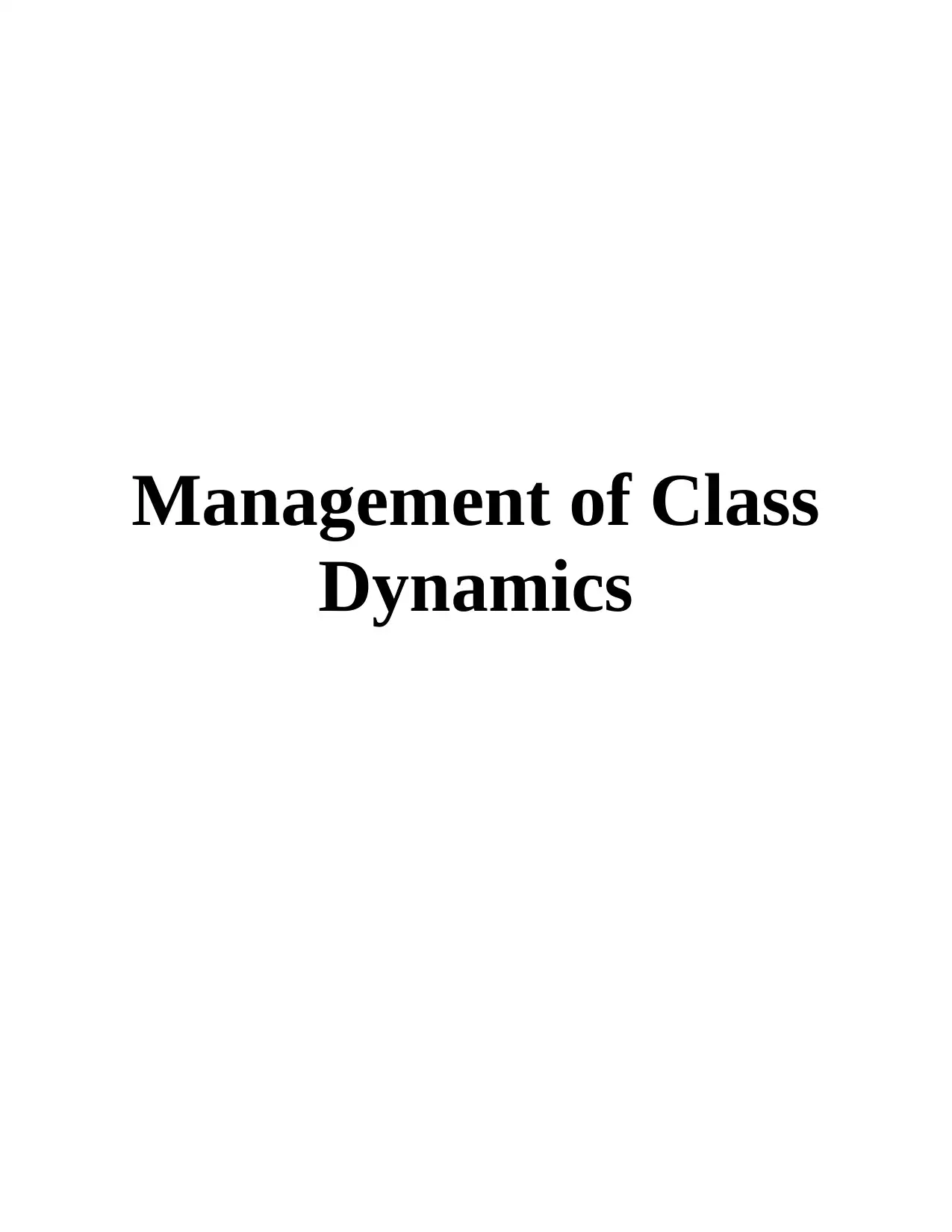
Management of Class
Dynamics
Dynamics
Paraphrase This Document
Need a fresh take? Get an instant paraphrase of this document with our AI Paraphraser
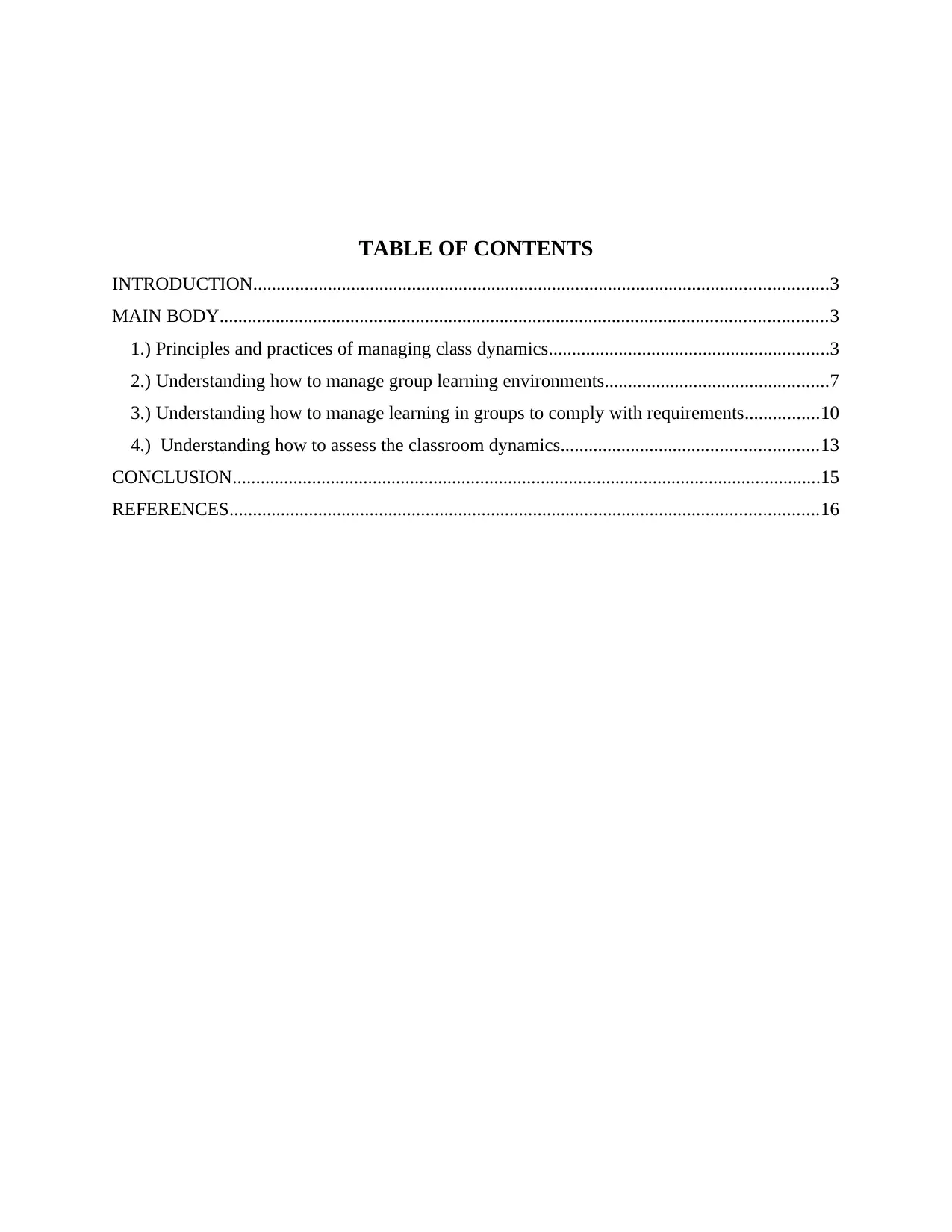
TABLE OF CONTENTS
INTRODUCTION...........................................................................................................................3
MAIN BODY..................................................................................................................................3
1.) Principles and practices of managing class dynamics............................................................3
2.) Understanding how to manage group learning environments................................................7
3.) Understanding how to manage learning in groups to comply with requirements................10
4.) Understanding how to assess the classroom dynamics.......................................................13
CONCLUSION..............................................................................................................................15
REFERENCES..............................................................................................................................16
INTRODUCTION...........................................................................................................................3
MAIN BODY..................................................................................................................................3
1.) Principles and practices of managing class dynamics............................................................3
2.) Understanding how to manage group learning environments................................................7
3.) Understanding how to manage learning in groups to comply with requirements................10
4.) Understanding how to assess the classroom dynamics.......................................................13
CONCLUSION..............................................................................................................................15
REFERENCES..............................................................................................................................16
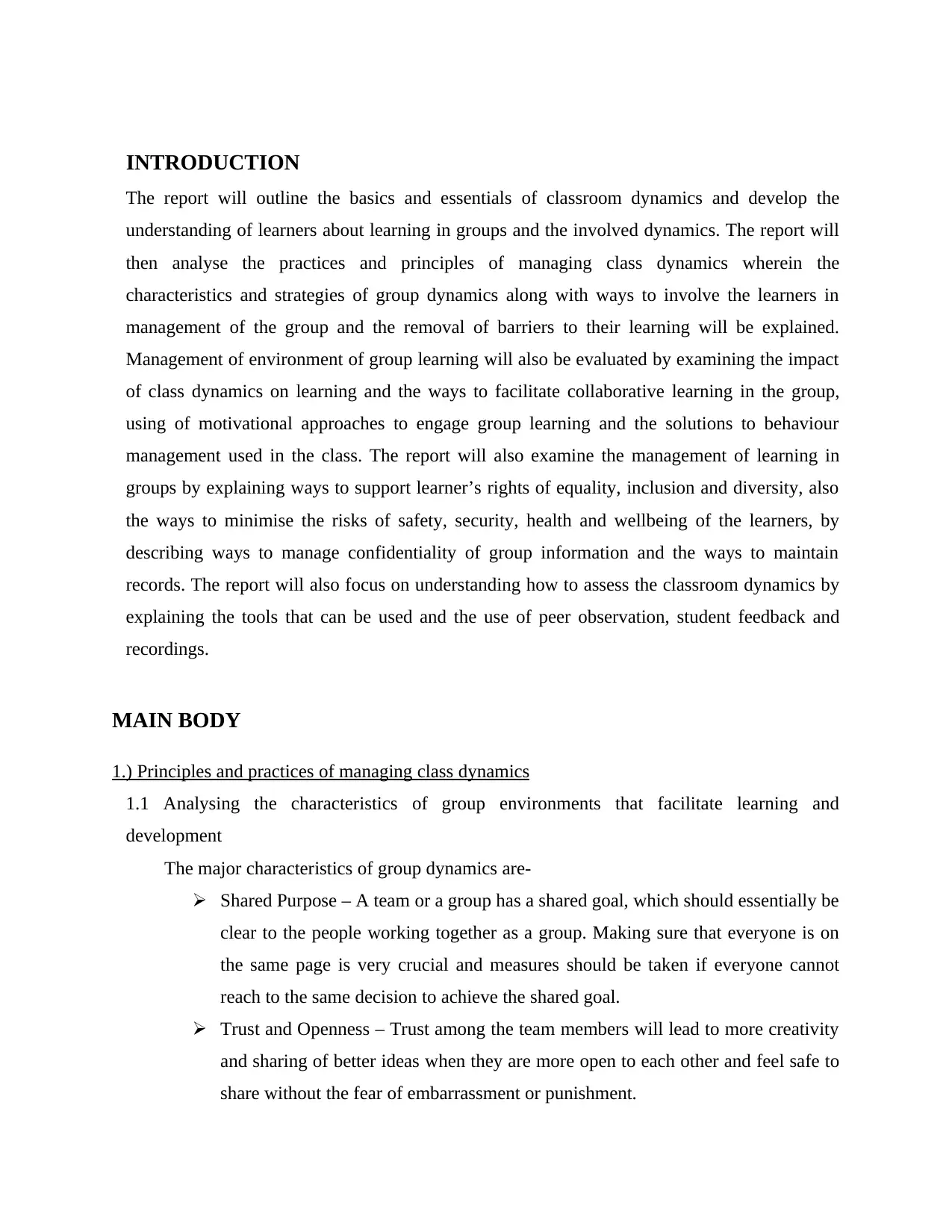
INTRODUCTION
The report will outline the basics and essentials of classroom dynamics and develop the
understanding of learners about learning in groups and the involved dynamics. The report will
then analyse the practices and principles of managing class dynamics wherein the
characteristics and strategies of group dynamics along with ways to involve the learners in
management of the group and the removal of barriers to their learning will be explained.
Management of environment of group learning will also be evaluated by examining the impact
of class dynamics on learning and the ways to facilitate collaborative learning in the group,
using of motivational approaches to engage group learning and the solutions to behaviour
management used in the class. The report will also examine the management of learning in
groups by explaining ways to support learner’s rights of equality, inclusion and diversity, also
the ways to minimise the risks of safety, security, health and wellbeing of the learners, by
describing ways to manage confidentiality of group information and the ways to maintain
records. The report will also focus on understanding how to assess the classroom dynamics by
explaining the tools that can be used and the use of peer observation, student feedback and
recordings.
MAIN BODY
1.) Principles and practices of managing class dynamics
1.1 Analysing the characteristics of group environments that facilitate learning and
development
The major characteristics of group dynamics are-
Shared Purpose – A team or a group has a shared goal, which should essentially be
clear to the people working together as a group. Making sure that everyone is on
the same page is very crucial and measures should be taken if everyone cannot
reach to the same decision to achieve the shared goal.
Trust and Openness – Trust among the team members will lead to more creativity
and sharing of better ideas when they are more open to each other and feel safe to
share without the fear of embarrassment or punishment.
The report will outline the basics and essentials of classroom dynamics and develop the
understanding of learners about learning in groups and the involved dynamics. The report will
then analyse the practices and principles of managing class dynamics wherein the
characteristics and strategies of group dynamics along with ways to involve the learners in
management of the group and the removal of barriers to their learning will be explained.
Management of environment of group learning will also be evaluated by examining the impact
of class dynamics on learning and the ways to facilitate collaborative learning in the group,
using of motivational approaches to engage group learning and the solutions to behaviour
management used in the class. The report will also examine the management of learning in
groups by explaining ways to support learner’s rights of equality, inclusion and diversity, also
the ways to minimise the risks of safety, security, health and wellbeing of the learners, by
describing ways to manage confidentiality of group information and the ways to maintain
records. The report will also focus on understanding how to assess the classroom dynamics by
explaining the tools that can be used and the use of peer observation, student feedback and
recordings.
MAIN BODY
1.) Principles and practices of managing class dynamics
1.1 Analysing the characteristics of group environments that facilitate learning and
development
The major characteristics of group dynamics are-
Shared Purpose – A team or a group has a shared goal, which should essentially be
clear to the people working together as a group. Making sure that everyone is on
the same page is very crucial and measures should be taken if everyone cannot
reach to the same decision to achieve the shared goal.
Trust and Openness – Trust among the team members will lead to more creativity
and sharing of better ideas when they are more open to each other and feel safe to
share without the fear of embarrassment or punishment.
⊘ This is a preview!⊘
Do you want full access?
Subscribe today to unlock all pages.

Trusted by 1+ million students worldwide
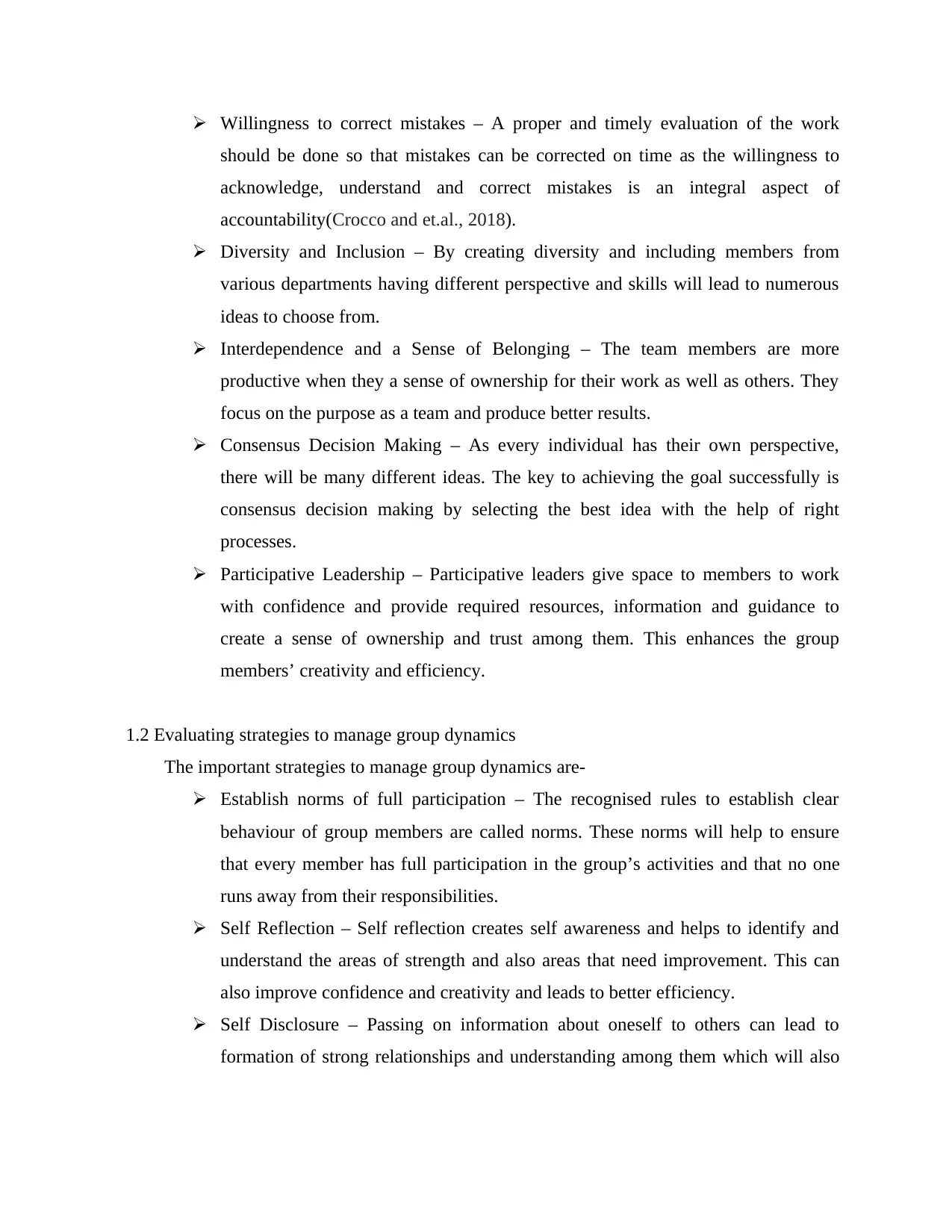
Willingness to correct mistakes – A proper and timely evaluation of the work
should be done so that mistakes can be corrected on time as the willingness to
acknowledge, understand and correct mistakes is an integral aspect of
accountability(Crocco and et.al., 2018).
Diversity and Inclusion – By creating diversity and including members from
various departments having different perspective and skills will lead to numerous
ideas to choose from.
Interdependence and a Sense of Belonging – The team members are more
productive when they a sense of ownership for their work as well as others. They
focus on the purpose as a team and produce better results.
Consensus Decision Making – As every individual has their own perspective,
there will be many different ideas. The key to achieving the goal successfully is
consensus decision making by selecting the best idea with the help of right
processes.
Participative Leadership – Participative leaders give space to members to work
with confidence and provide required resources, information and guidance to
create a sense of ownership and trust among them. This enhances the group
members’ creativity and efficiency.
1.2 Evaluating strategies to manage group dynamics
The important strategies to manage group dynamics are-
Establish norms of full participation – The recognised rules to establish clear
behaviour of group members are called norms. These norms will help to ensure
that every member has full participation in the group’s activities and that no one
runs away from their responsibilities.
Self Reflection – Self reflection creates self awareness and helps to identify and
understand the areas of strength and also areas that need improvement. This can
also improve confidence and creativity and leads to better efficiency.
Self Disclosure – Passing on information about oneself to others can lead to
formation of strong relationships and understanding among them which will also
should be done so that mistakes can be corrected on time as the willingness to
acknowledge, understand and correct mistakes is an integral aspect of
accountability(Crocco and et.al., 2018).
Diversity and Inclusion – By creating diversity and including members from
various departments having different perspective and skills will lead to numerous
ideas to choose from.
Interdependence and a Sense of Belonging – The team members are more
productive when they a sense of ownership for their work as well as others. They
focus on the purpose as a team and produce better results.
Consensus Decision Making – As every individual has their own perspective,
there will be many different ideas. The key to achieving the goal successfully is
consensus decision making by selecting the best idea with the help of right
processes.
Participative Leadership – Participative leaders give space to members to work
with confidence and provide required resources, information and guidance to
create a sense of ownership and trust among them. This enhances the group
members’ creativity and efficiency.
1.2 Evaluating strategies to manage group dynamics
The important strategies to manage group dynamics are-
Establish norms of full participation – The recognised rules to establish clear
behaviour of group members are called norms. These norms will help to ensure
that every member has full participation in the group’s activities and that no one
runs away from their responsibilities.
Self Reflection – Self reflection creates self awareness and helps to identify and
understand the areas of strength and also areas that need improvement. This can
also improve confidence and creativity and leads to better efficiency.
Self Disclosure – Passing on information about oneself to others can lead to
formation of strong relationships and understanding among them which will also
Paraphrase This Document
Need a fresh take? Get an instant paraphrase of this document with our AI Paraphraser
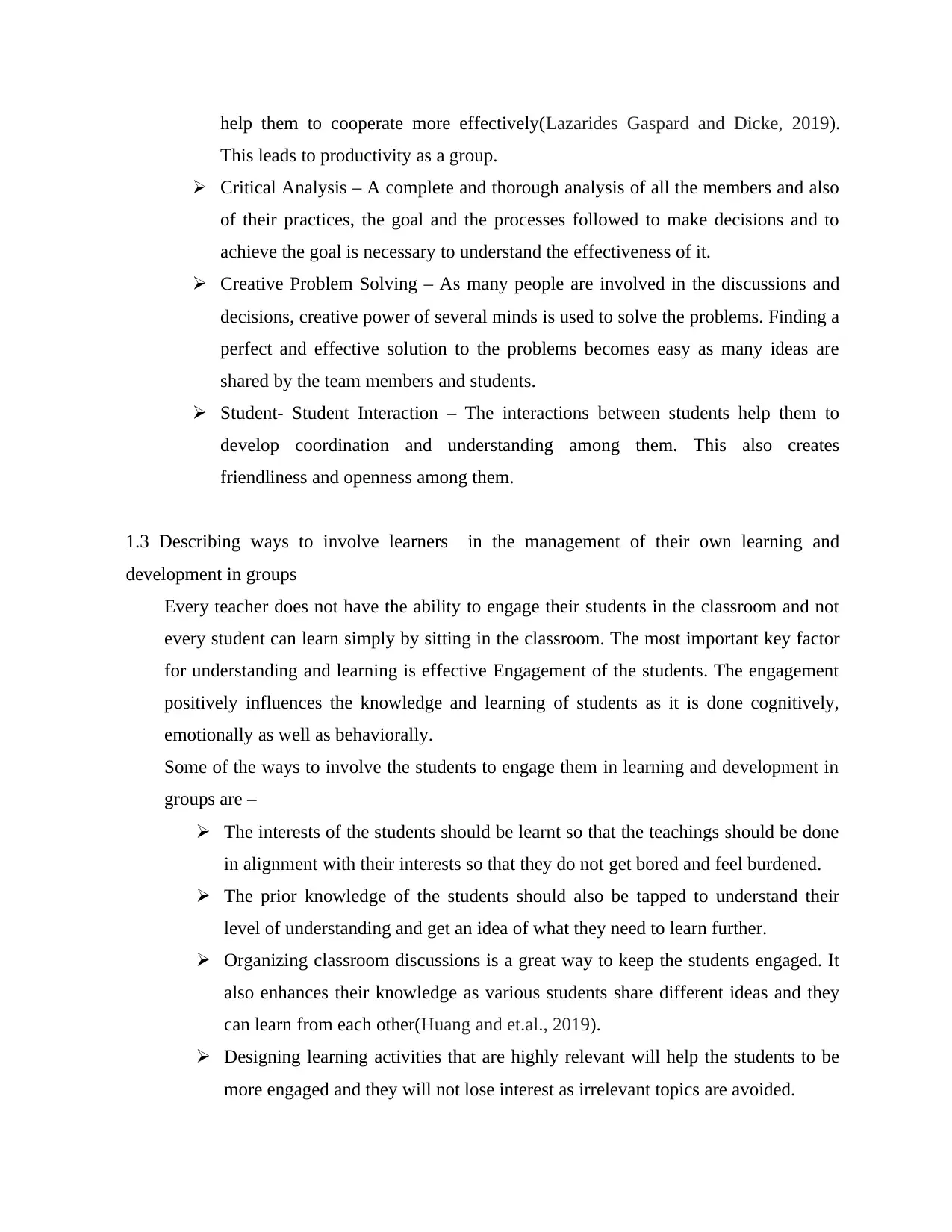
help them to cooperate more effectively(Lazarides Gaspard and Dicke, 2019).
This leads to productivity as a group.
Critical Analysis – A complete and thorough analysis of all the members and also
of their practices, the goal and the processes followed to make decisions and to
achieve the goal is necessary to understand the effectiveness of it.
Creative Problem Solving – As many people are involved in the discussions and
decisions, creative power of several minds is used to solve the problems. Finding a
perfect and effective solution to the problems becomes easy as many ideas are
shared by the team members and students.
Student- Student Interaction – The interactions between students help them to
develop coordination and understanding among them. This also creates
friendliness and openness among them.
1.3 Describing ways to involve learners in the management of their own learning and
development in groups
Every teacher does not have the ability to engage their students in the classroom and not
every student can learn simply by sitting in the classroom. The most important key factor
for understanding and learning is effective Engagement of the students. The engagement
positively influences the knowledge and learning of students as it is done cognitively,
emotionally as well as behaviorally.
Some of the ways to involve the students to engage them in learning and development in
groups are –
The interests of the students should be learnt so that the teachings should be done
in alignment with their interests so that they do not get bored and feel burdened.
The prior knowledge of the students should also be tapped to understand their
level of understanding and get an idea of what they need to learn further.
Organizing classroom discussions is a great way to keep the students engaged. It
also enhances their knowledge as various students share different ideas and they
can learn from each other(Huang and et.al., 2019).
Designing learning activities that are highly relevant will help the students to be
more engaged and they will not lose interest as irrelevant topics are avoided.
This leads to productivity as a group.
Critical Analysis – A complete and thorough analysis of all the members and also
of their practices, the goal and the processes followed to make decisions and to
achieve the goal is necessary to understand the effectiveness of it.
Creative Problem Solving – As many people are involved in the discussions and
decisions, creative power of several minds is used to solve the problems. Finding a
perfect and effective solution to the problems becomes easy as many ideas are
shared by the team members and students.
Student- Student Interaction – The interactions between students help them to
develop coordination and understanding among them. This also creates
friendliness and openness among them.
1.3 Describing ways to involve learners in the management of their own learning and
development in groups
Every teacher does not have the ability to engage their students in the classroom and not
every student can learn simply by sitting in the classroom. The most important key factor
for understanding and learning is effective Engagement of the students. The engagement
positively influences the knowledge and learning of students as it is done cognitively,
emotionally as well as behaviorally.
Some of the ways to involve the students to engage them in learning and development in
groups are –
The interests of the students should be learnt so that the teachings should be done
in alignment with their interests so that they do not get bored and feel burdened.
The prior knowledge of the students should also be tapped to understand their
level of understanding and get an idea of what they need to learn further.
Organizing classroom discussions is a great way to keep the students engaged. It
also enhances their knowledge as various students share different ideas and they
can learn from each other(Huang and et.al., 2019).
Designing learning activities that are highly relevant will help the students to be
more engaged and they will not lose interest as irrelevant topics are avoided.
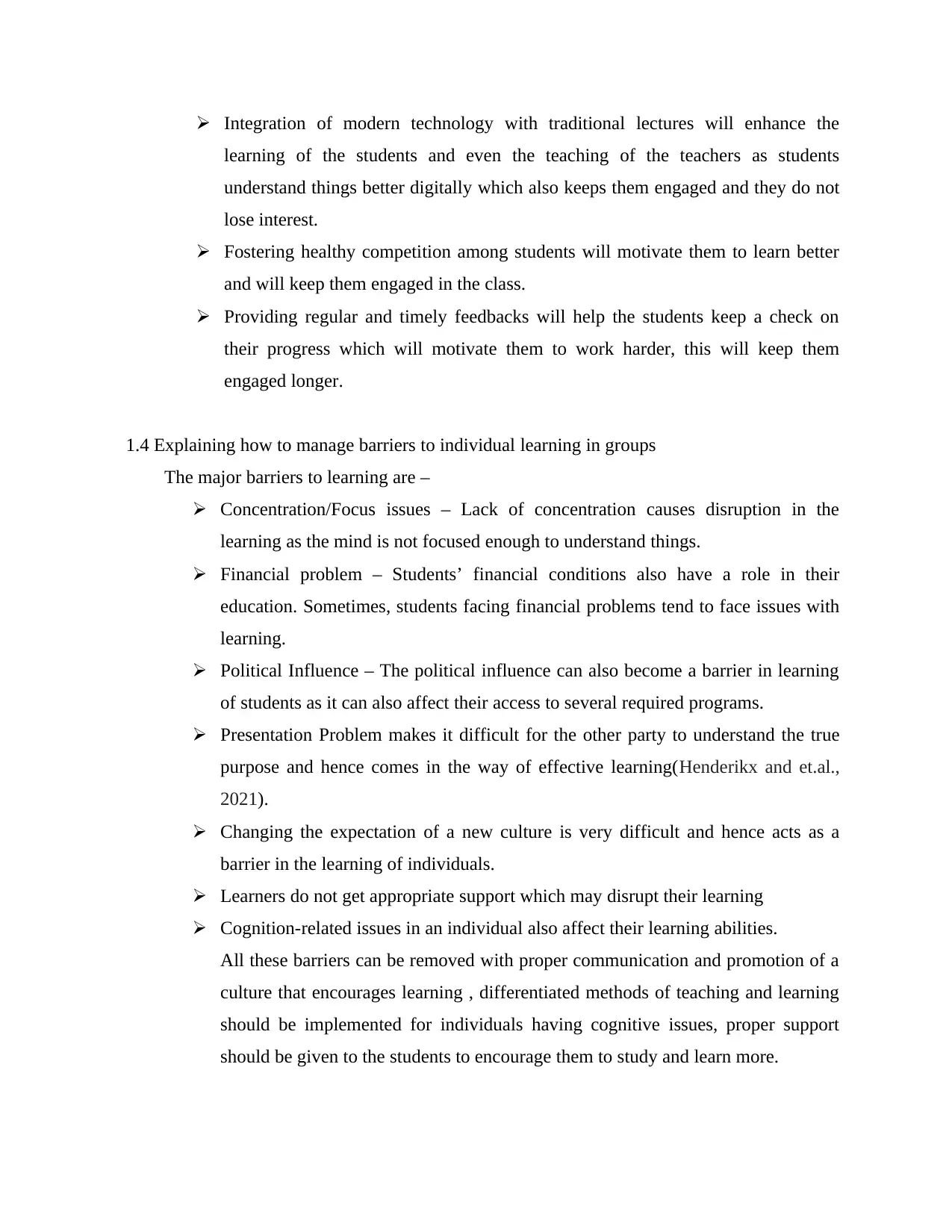
Integration of modern technology with traditional lectures will enhance the
learning of the students and even the teaching of the teachers as students
understand things better digitally which also keeps them engaged and they do not
lose interest.
Fostering healthy competition among students will motivate them to learn better
and will keep them engaged in the class.
Providing regular and timely feedbacks will help the students keep a check on
their progress which will motivate them to work harder, this will keep them
engaged longer.
1.4 Explaining how to manage barriers to individual learning in groups
The major barriers to learning are –
Concentration/Focus issues – Lack of concentration causes disruption in the
learning as the mind is not focused enough to understand things.
Financial problem – Students’ financial conditions also have a role in their
education. Sometimes, students facing financial problems tend to face issues with
learning.
Political Influence – The political influence can also become a barrier in learning
of students as it can also affect their access to several required programs.
Presentation Problem makes it difficult for the other party to understand the true
purpose and hence comes in the way of effective learning(Henderikx and et.al.,
2021).
Changing the expectation of a new culture is very difficult and hence acts as a
barrier in the learning of individuals.
Learners do not get appropriate support which may disrupt their learning
Cognition-related issues in an individual also affect their learning abilities.
All these barriers can be removed with proper communication and promotion of a
culture that encourages learning , differentiated methods of teaching and learning
should be implemented for individuals having cognitive issues, proper support
should be given to the students to encourage them to study and learn more.
learning of the students and even the teaching of the teachers as students
understand things better digitally which also keeps them engaged and they do not
lose interest.
Fostering healthy competition among students will motivate them to learn better
and will keep them engaged in the class.
Providing regular and timely feedbacks will help the students keep a check on
their progress which will motivate them to work harder, this will keep them
engaged longer.
1.4 Explaining how to manage barriers to individual learning in groups
The major barriers to learning are –
Concentration/Focus issues – Lack of concentration causes disruption in the
learning as the mind is not focused enough to understand things.
Financial problem – Students’ financial conditions also have a role in their
education. Sometimes, students facing financial problems tend to face issues with
learning.
Political Influence – The political influence can also become a barrier in learning
of students as it can also affect their access to several required programs.
Presentation Problem makes it difficult for the other party to understand the true
purpose and hence comes in the way of effective learning(Henderikx and et.al.,
2021).
Changing the expectation of a new culture is very difficult and hence acts as a
barrier in the learning of individuals.
Learners do not get appropriate support which may disrupt their learning
Cognition-related issues in an individual also affect their learning abilities.
All these barriers can be removed with proper communication and promotion of a
culture that encourages learning , differentiated methods of teaching and learning
should be implemented for individuals having cognitive issues, proper support
should be given to the students to encourage them to study and learn more.
⊘ This is a preview!⊘
Do you want full access?
Subscribe today to unlock all pages.

Trusted by 1+ million students worldwide
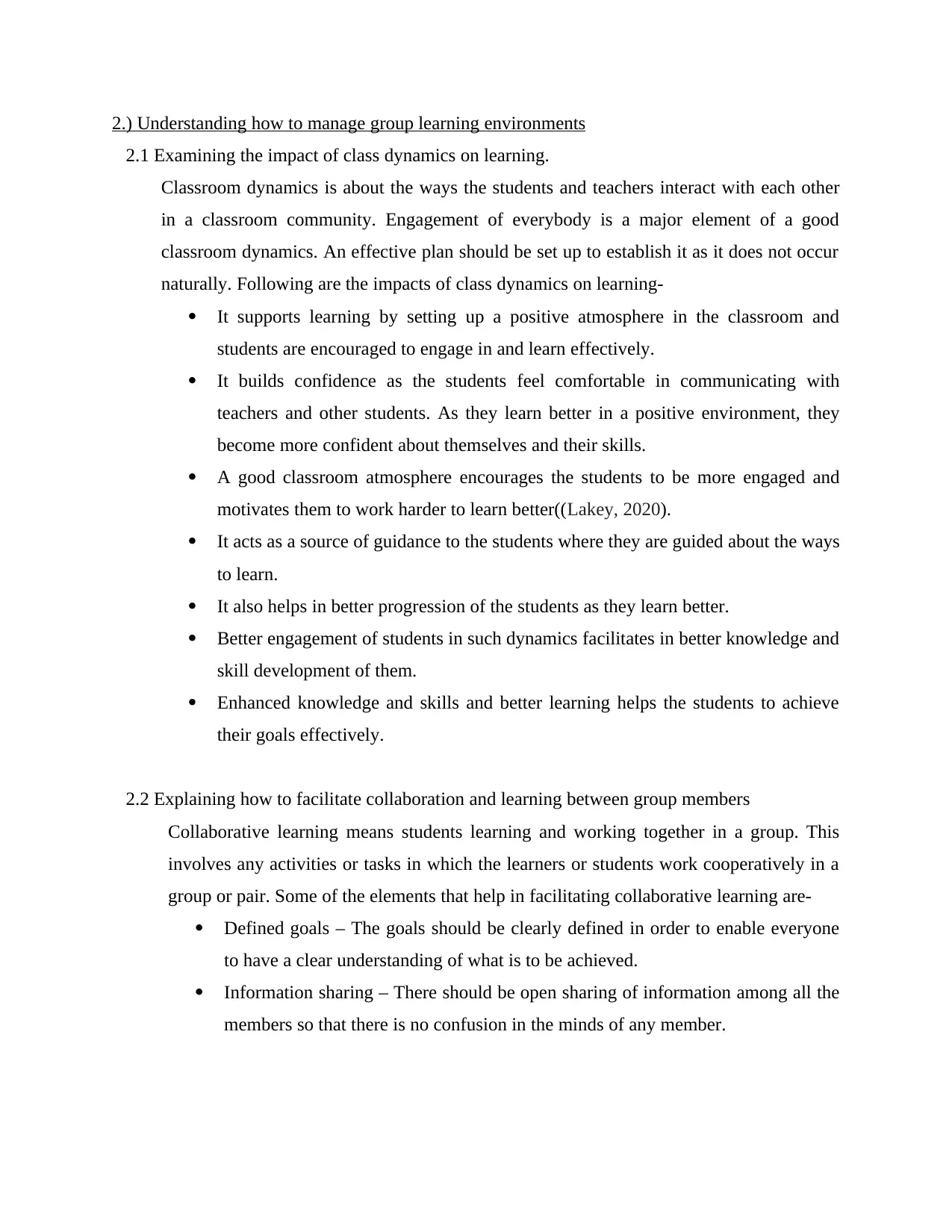
2.) Understanding how to manage group learning environments
2.1 Examining the impact of class dynamics on learning.
Classroom dynamics is about the ways the students and teachers interact with each other
in a classroom community. Engagement of everybody is a major element of a good
classroom dynamics. An effective plan should be set up to establish it as it does not occur
naturally. Following are the impacts of class dynamics on learning-
It supports learning by setting up a positive atmosphere in the classroom and
students are encouraged to engage in and learn effectively.
It builds confidence as the students feel comfortable in communicating with
teachers and other students. As they learn better in a positive environment, they
become more confident about themselves and their skills.
A good classroom atmosphere encourages the students to be more engaged and
motivates them to work harder to learn better((Lakey, 2020).
It acts as a source of guidance to the students where they are guided about the ways
to learn.
It also helps in better progression of the students as they learn better.
Better engagement of students in such dynamics facilitates in better knowledge and
skill development of them.
Enhanced knowledge and skills and better learning helps the students to achieve
their goals effectively.
2.2 Explaining how to facilitate collaboration and learning between group members
Collaborative learning means students learning and working together in a group. This
involves any activities or tasks in which the learners or students work cooperatively in a
group or pair. Some of the elements that help in facilitating collaborative learning are-
Defined goals – The goals should be clearly defined in order to enable everyone
to have a clear understanding of what is to be achieved.
Information sharing – There should be open sharing of information among all the
members so that there is no confusion in the minds of any member.
2.1 Examining the impact of class dynamics on learning.
Classroom dynamics is about the ways the students and teachers interact with each other
in a classroom community. Engagement of everybody is a major element of a good
classroom dynamics. An effective plan should be set up to establish it as it does not occur
naturally. Following are the impacts of class dynamics on learning-
It supports learning by setting up a positive atmosphere in the classroom and
students are encouraged to engage in and learn effectively.
It builds confidence as the students feel comfortable in communicating with
teachers and other students. As they learn better in a positive environment, they
become more confident about themselves and their skills.
A good classroom atmosphere encourages the students to be more engaged and
motivates them to work harder to learn better((Lakey, 2020).
It acts as a source of guidance to the students where they are guided about the ways
to learn.
It also helps in better progression of the students as they learn better.
Better engagement of students in such dynamics facilitates in better knowledge and
skill development of them.
Enhanced knowledge and skills and better learning helps the students to achieve
their goals effectively.
2.2 Explaining how to facilitate collaboration and learning between group members
Collaborative learning means students learning and working together in a group. This
involves any activities or tasks in which the learners or students work cooperatively in a
group or pair. Some of the elements that help in facilitating collaborative learning are-
Defined goals – The goals should be clearly defined in order to enable everyone
to have a clear understanding of what is to be achieved.
Information sharing – There should be open sharing of information among all the
members so that there is no confusion in the minds of any member.
Paraphrase This Document
Need a fresh take? Get an instant paraphrase of this document with our AI Paraphraser
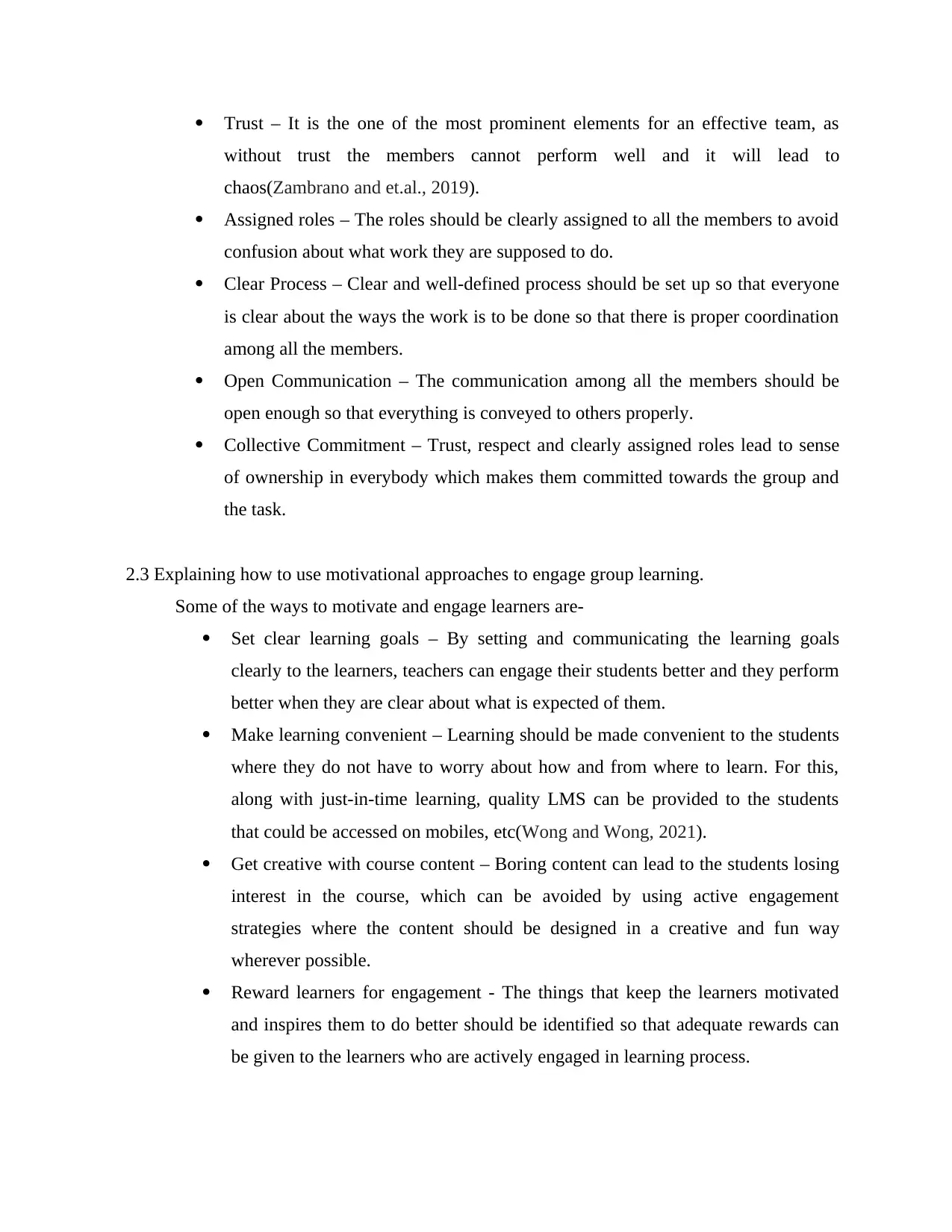
Trust – It is the one of the most prominent elements for an effective team, as
without trust the members cannot perform well and it will lead to
chaos(Zambrano and et.al., 2019).
Assigned roles – The roles should be clearly assigned to all the members to avoid
confusion about what work they are supposed to do.
Clear Process – Clear and well-defined process should be set up so that everyone
is clear about the ways the work is to be done so that there is proper coordination
among all the members.
Open Communication – The communication among all the members should be
open enough so that everything is conveyed to others properly.
Collective Commitment – Trust, respect and clearly assigned roles lead to sense
of ownership in everybody which makes them committed towards the group and
the task.
2.3 Explaining how to use motivational approaches to engage group learning.
Some of the ways to motivate and engage learners are-
Set clear learning goals – By setting and communicating the learning goals
clearly to the learners, teachers can engage their students better and they perform
better when they are clear about what is expected of them.
Make learning convenient – Learning should be made convenient to the students
where they do not have to worry about how and from where to learn. For this,
along with just-in-time learning, quality LMS can be provided to the students
that could be accessed on mobiles, etc(Wong and Wong, 2021).
Get creative with course content – Boring content can lead to the students losing
interest in the course, which can be avoided by using active engagement
strategies where the content should be designed in a creative and fun way
wherever possible.
Reward learners for engagement - The things that keep the learners motivated
and inspires them to do better should be identified so that adequate rewards can
be given to the learners who are actively engaged in learning process.
without trust the members cannot perform well and it will lead to
chaos(Zambrano and et.al., 2019).
Assigned roles – The roles should be clearly assigned to all the members to avoid
confusion about what work they are supposed to do.
Clear Process – Clear and well-defined process should be set up so that everyone
is clear about the ways the work is to be done so that there is proper coordination
among all the members.
Open Communication – The communication among all the members should be
open enough so that everything is conveyed to others properly.
Collective Commitment – Trust, respect and clearly assigned roles lead to sense
of ownership in everybody which makes them committed towards the group and
the task.
2.3 Explaining how to use motivational approaches to engage group learning.
Some of the ways to motivate and engage learners are-
Set clear learning goals – By setting and communicating the learning goals
clearly to the learners, teachers can engage their students better and they perform
better when they are clear about what is expected of them.
Make learning convenient – Learning should be made convenient to the students
where they do not have to worry about how and from where to learn. For this,
along with just-in-time learning, quality LMS can be provided to the students
that could be accessed on mobiles, etc(Wong and Wong, 2021).
Get creative with course content – Boring content can lead to the students losing
interest in the course, which can be avoided by using active engagement
strategies where the content should be designed in a creative and fun way
wherever possible.
Reward learners for engagement - The things that keep the learners motivated
and inspires them to do better should be identified so that adequate rewards can
be given to the learners who are actively engaged in learning process.
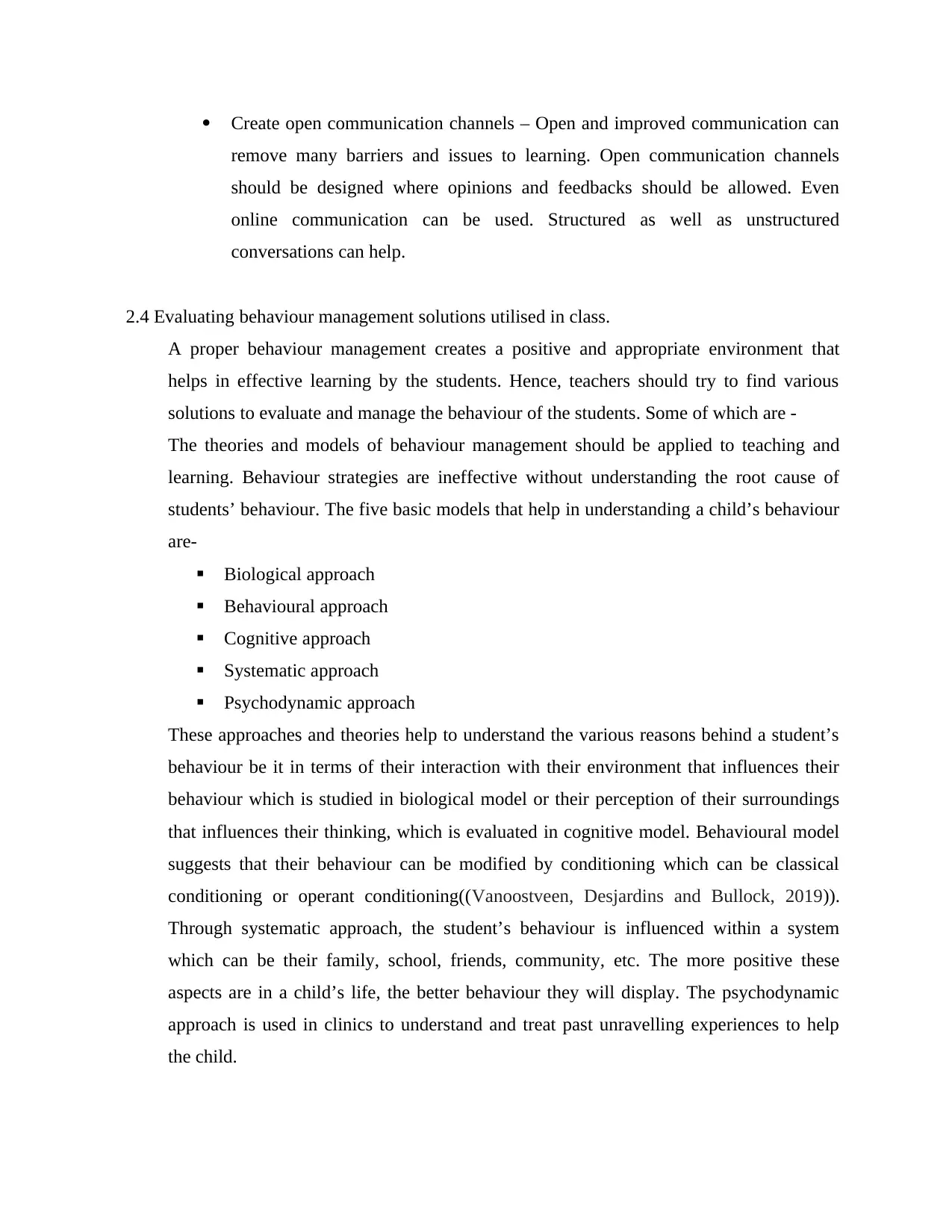
Create open communication channels – Open and improved communication can
remove many barriers and issues to learning. Open communication channels
should be designed where opinions and feedbacks should be allowed. Even
online communication can be used. Structured as well as unstructured
conversations can help.
2.4 Evaluating behaviour management solutions utilised in class.
A proper behaviour management creates a positive and appropriate environment that
helps in effective learning by the students. Hence, teachers should try to find various
solutions to evaluate and manage the behaviour of the students. Some of which are -
The theories and models of behaviour management should be applied to teaching and
learning. Behaviour strategies are ineffective without understanding the root cause of
students’ behaviour. The five basic models that help in understanding a child’s behaviour
are-
Biological approach
Behavioural approach
Cognitive approach
Systematic approach
Psychodynamic approach
These approaches and theories help to understand the various reasons behind a student’s
behaviour be it in terms of their interaction with their environment that influences their
behaviour which is studied in biological model or their perception of their surroundings
that influences their thinking, which is evaluated in cognitive model. Behavioural model
suggests that their behaviour can be modified by conditioning which can be classical
conditioning or operant conditioning((Vanoostveen, Desjardins and Bullock, 2019)).
Through systematic approach, the student’s behaviour is influenced within a system
which can be their family, school, friends, community, etc. The more positive these
aspects are in a child’s life, the better behaviour they will display. The psychodynamic
approach is used in clinics to understand and treat past unravelling experiences to help
the child.
remove many barriers and issues to learning. Open communication channels
should be designed where opinions and feedbacks should be allowed. Even
online communication can be used. Structured as well as unstructured
conversations can help.
2.4 Evaluating behaviour management solutions utilised in class.
A proper behaviour management creates a positive and appropriate environment that
helps in effective learning by the students. Hence, teachers should try to find various
solutions to evaluate and manage the behaviour of the students. Some of which are -
The theories and models of behaviour management should be applied to teaching and
learning. Behaviour strategies are ineffective without understanding the root cause of
students’ behaviour. The five basic models that help in understanding a child’s behaviour
are-
Biological approach
Behavioural approach
Cognitive approach
Systematic approach
Psychodynamic approach
These approaches and theories help to understand the various reasons behind a student’s
behaviour be it in terms of their interaction with their environment that influences their
behaviour which is studied in biological model or their perception of their surroundings
that influences their thinking, which is evaluated in cognitive model. Behavioural model
suggests that their behaviour can be modified by conditioning which can be classical
conditioning or operant conditioning((Vanoostveen, Desjardins and Bullock, 2019)).
Through systematic approach, the student’s behaviour is influenced within a system
which can be their family, school, friends, community, etc. The more positive these
aspects are in a child’s life, the better behaviour they will display. The psychodynamic
approach is used in clinics to understand and treat past unravelling experiences to help
the child.
⊘ This is a preview!⊘
Do you want full access?
Subscribe today to unlock all pages.

Trusted by 1+ million students worldwide
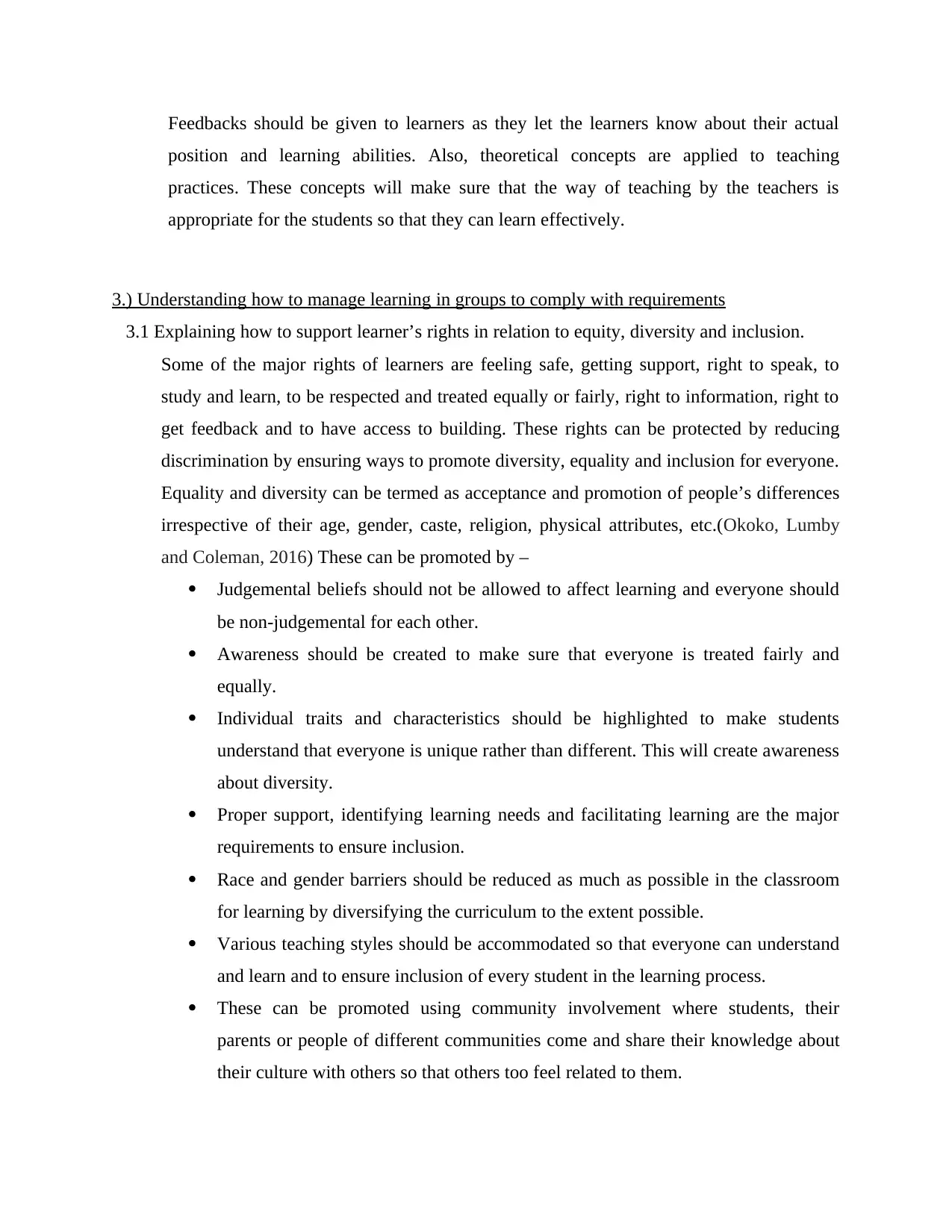
Feedbacks should be given to learners as they let the learners know about their actual
position and learning abilities. Also, theoretical concepts are applied to teaching
practices. These concepts will make sure that the way of teaching by the teachers is
appropriate for the students so that they can learn effectively.
3.) Understanding how to manage learning in groups to comply with requirements
3.1 Explaining how to support learner’s rights in relation to equity, diversity and inclusion.
Some of the major rights of learners are feeling safe, getting support, right to speak, to
study and learn, to be respected and treated equally or fairly, right to information, right to
get feedback and to have access to building. These rights can be protected by reducing
discrimination by ensuring ways to promote diversity, equality and inclusion for everyone.
Equality and diversity can be termed as acceptance and promotion of people’s differences
irrespective of their age, gender, caste, religion, physical attributes, etc.(Okoko, Lumby
and Coleman, 2016) These can be promoted by –
Judgemental beliefs should not be allowed to affect learning and everyone should
be non-judgemental for each other.
Awareness should be created to make sure that everyone is treated fairly and
equally.
Individual traits and characteristics should be highlighted to make students
understand that everyone is unique rather than different. This will create awareness
about diversity.
Proper support, identifying learning needs and facilitating learning are the major
requirements to ensure inclusion.
Race and gender barriers should be reduced as much as possible in the classroom
for learning by diversifying the curriculum to the extent possible.
Various teaching styles should be accommodated so that everyone can understand
and learn and to ensure inclusion of every student in the learning process.
These can be promoted using community involvement where students, their
parents or people of different communities come and share their knowledge about
their culture with others so that others too feel related to them.
position and learning abilities. Also, theoretical concepts are applied to teaching
practices. These concepts will make sure that the way of teaching by the teachers is
appropriate for the students so that they can learn effectively.
3.) Understanding how to manage learning in groups to comply with requirements
3.1 Explaining how to support learner’s rights in relation to equity, diversity and inclusion.
Some of the major rights of learners are feeling safe, getting support, right to speak, to
study and learn, to be respected and treated equally or fairly, right to information, right to
get feedback and to have access to building. These rights can be protected by reducing
discrimination by ensuring ways to promote diversity, equality and inclusion for everyone.
Equality and diversity can be termed as acceptance and promotion of people’s differences
irrespective of their age, gender, caste, religion, physical attributes, etc.(Okoko, Lumby
and Coleman, 2016) These can be promoted by –
Judgemental beliefs should not be allowed to affect learning and everyone should
be non-judgemental for each other.
Awareness should be created to make sure that everyone is treated fairly and
equally.
Individual traits and characteristics should be highlighted to make students
understand that everyone is unique rather than different. This will create awareness
about diversity.
Proper support, identifying learning needs and facilitating learning are the major
requirements to ensure inclusion.
Race and gender barriers should be reduced as much as possible in the classroom
for learning by diversifying the curriculum to the extent possible.
Various teaching styles should be accommodated so that everyone can understand
and learn and to ensure inclusion of every student in the learning process.
These can be promoted using community involvement where students, their
parents or people of different communities come and share their knowledge about
their culture with others so that others too feel related to them.
Paraphrase This Document
Need a fresh take? Get an instant paraphrase of this document with our AI Paraphraser
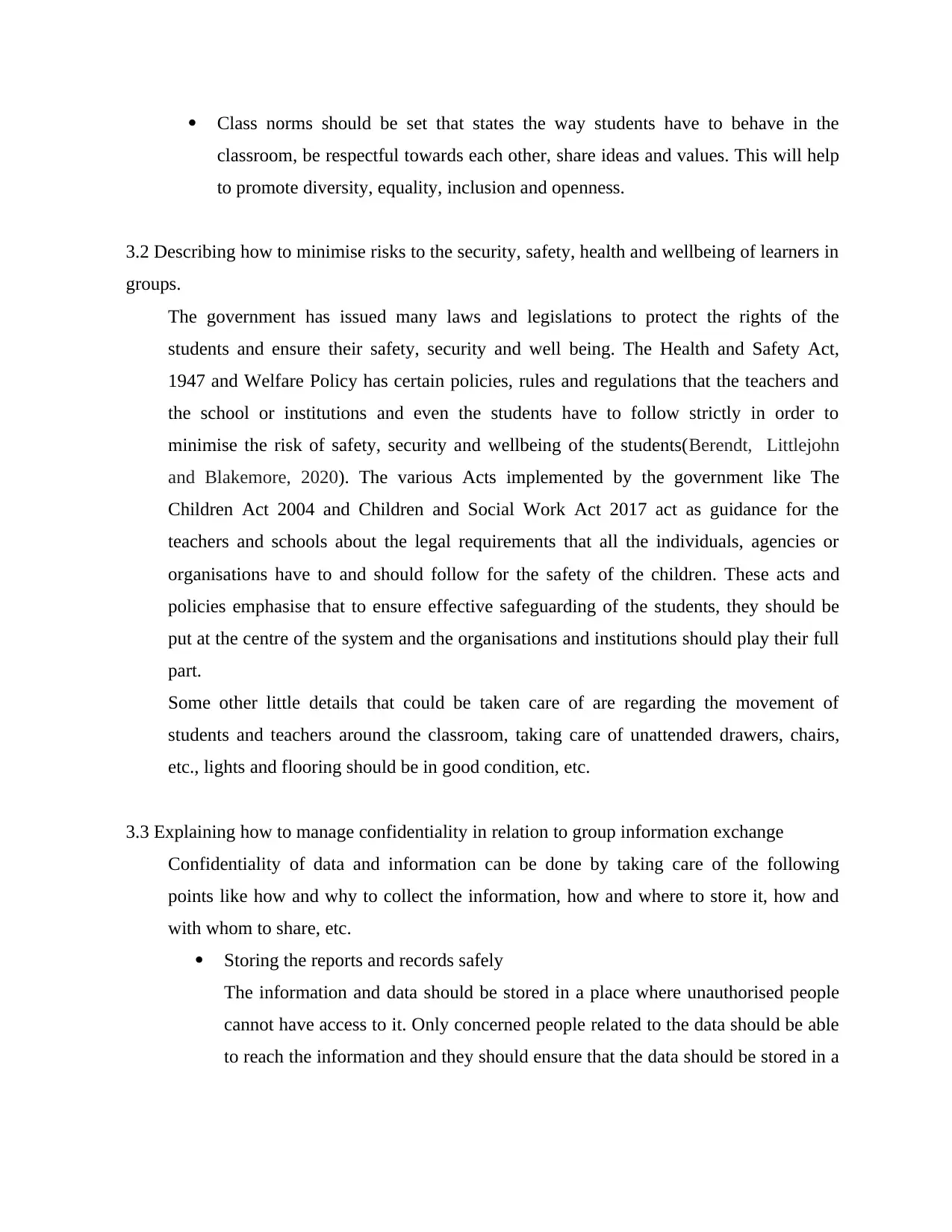
Class norms should be set that states the way students have to behave in the
classroom, be respectful towards each other, share ideas and values. This will help
to promote diversity, equality, inclusion and openness.
3.2 Describing how to minimise risks to the security, safety, health and wellbeing of learners in
groups.
The government has issued many laws and legislations to protect the rights of the
students and ensure their safety, security and well being. The Health and Safety Act,
1947 and Welfare Policy has certain policies, rules and regulations that the teachers and
the school or institutions and even the students have to follow strictly in order to
minimise the risk of safety, security and wellbeing of the students(Berendt, Littlejohn
and Blakemore, 2020). The various Acts implemented by the government like The
Children Act 2004 and Children and Social Work Act 2017 act as guidance for the
teachers and schools about the legal requirements that all the individuals, agencies or
organisations have to and should follow for the safety of the children. These acts and
policies emphasise that to ensure effective safeguarding of the students, they should be
put at the centre of the system and the organisations and institutions should play their full
part.
Some other little details that could be taken care of are regarding the movement of
students and teachers around the classroom, taking care of unattended drawers, chairs,
etc., lights and flooring should be in good condition, etc.
3.3 Explaining how to manage confidentiality in relation to group information exchange
Confidentiality of data and information can be done by taking care of the following
points like how and why to collect the information, how and where to store it, how and
with whom to share, etc.
Storing the reports and records safely
The information and data should be stored in a place where unauthorised people
cannot have access to it. Only concerned people related to the data should be able
to reach the information and they should ensure that the data should be stored in a
classroom, be respectful towards each other, share ideas and values. This will help
to promote diversity, equality, inclusion and openness.
3.2 Describing how to minimise risks to the security, safety, health and wellbeing of learners in
groups.
The government has issued many laws and legislations to protect the rights of the
students and ensure their safety, security and well being. The Health and Safety Act,
1947 and Welfare Policy has certain policies, rules and regulations that the teachers and
the school or institutions and even the students have to follow strictly in order to
minimise the risk of safety, security and wellbeing of the students(Berendt, Littlejohn
and Blakemore, 2020). The various Acts implemented by the government like The
Children Act 2004 and Children and Social Work Act 2017 act as guidance for the
teachers and schools about the legal requirements that all the individuals, agencies or
organisations have to and should follow for the safety of the children. These acts and
policies emphasise that to ensure effective safeguarding of the students, they should be
put at the centre of the system and the organisations and institutions should play their full
part.
Some other little details that could be taken care of are regarding the movement of
students and teachers around the classroom, taking care of unattended drawers, chairs,
etc., lights and flooring should be in good condition, etc.
3.3 Explaining how to manage confidentiality in relation to group information exchange
Confidentiality of data and information can be done by taking care of the following
points like how and why to collect the information, how and where to store it, how and
with whom to share, etc.
Storing the reports and records safely
The information and data should be stored in a place where unauthorised people
cannot have access to it. Only concerned people related to the data should be able
to reach the information and they should ensure that the data should be stored in a
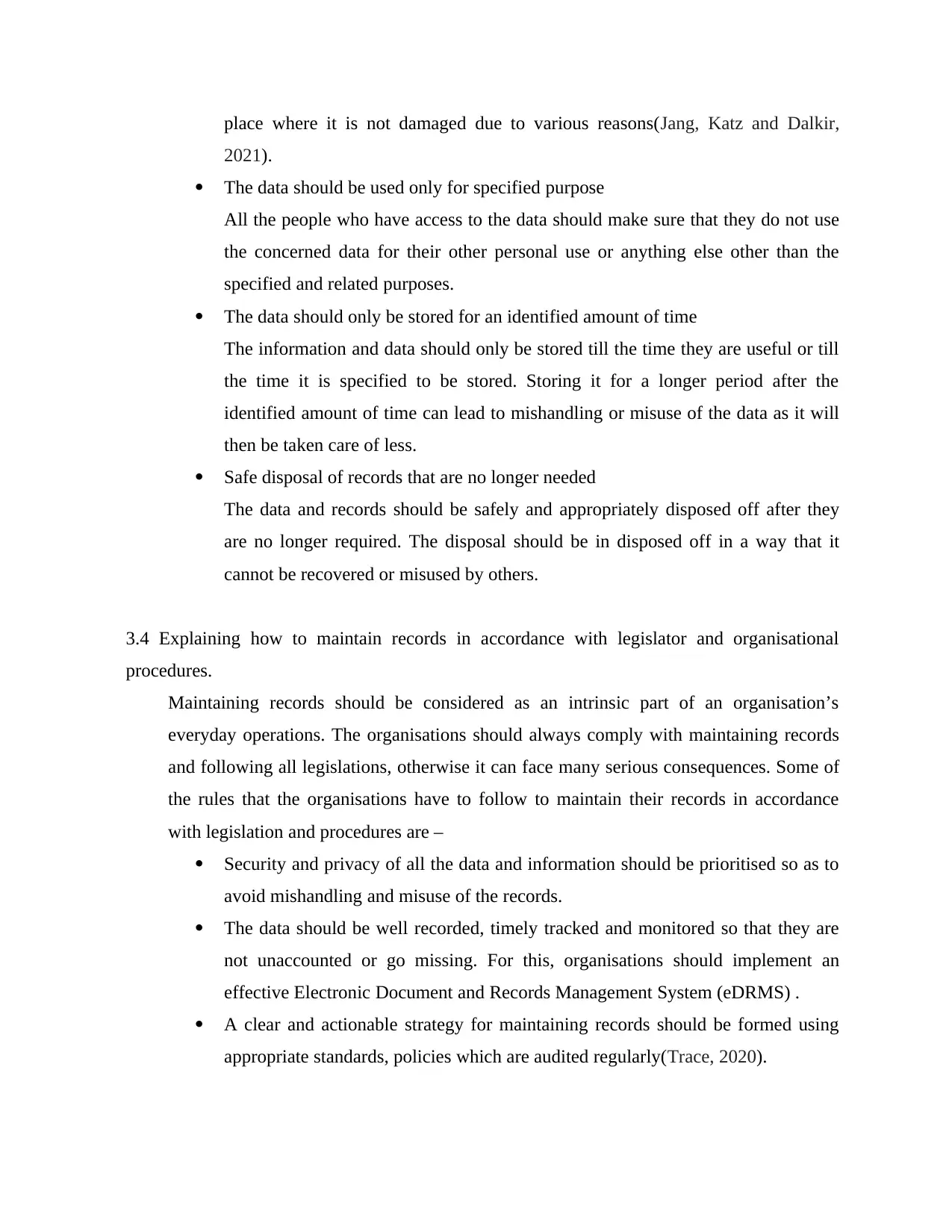
place where it is not damaged due to various reasons(Jang, Katz and Dalkir,
2021).
The data should be used only for specified purpose
All the people who have access to the data should make sure that they do not use
the concerned data for their other personal use or anything else other than the
specified and related purposes.
The data should only be stored for an identified amount of time
The information and data should only be stored till the time they are useful or till
the time it is specified to be stored. Storing it for a longer period after the
identified amount of time can lead to mishandling or misuse of the data as it will
then be taken care of less.
Safe disposal of records that are no longer needed
The data and records should be safely and appropriately disposed off after they
are no longer required. The disposal should be in disposed off in a way that it
cannot be recovered or misused by others.
3.4 Explaining how to maintain records in accordance with legislator and organisational
procedures.
Maintaining records should be considered as an intrinsic part of an organisation’s
everyday operations. The organisations should always comply with maintaining records
and following all legislations, otherwise it can face many serious consequences. Some of
the rules that the organisations have to follow to maintain their records in accordance
with legislation and procedures are –
Security and privacy of all the data and information should be prioritised so as to
avoid mishandling and misuse of the records.
The data should be well recorded, timely tracked and monitored so that they are
not unaccounted or go missing. For this, organisations should implement an
effective Electronic Document and Records Management System (eDRMS) .
A clear and actionable strategy for maintaining records should be formed using
appropriate standards, policies which are audited regularly(Trace, 2020).
2021).
The data should be used only for specified purpose
All the people who have access to the data should make sure that they do not use
the concerned data for their other personal use or anything else other than the
specified and related purposes.
The data should only be stored for an identified amount of time
The information and data should only be stored till the time they are useful or till
the time it is specified to be stored. Storing it for a longer period after the
identified amount of time can lead to mishandling or misuse of the data as it will
then be taken care of less.
Safe disposal of records that are no longer needed
The data and records should be safely and appropriately disposed off after they
are no longer required. The disposal should be in disposed off in a way that it
cannot be recovered or misused by others.
3.4 Explaining how to maintain records in accordance with legislator and organisational
procedures.
Maintaining records should be considered as an intrinsic part of an organisation’s
everyday operations. The organisations should always comply with maintaining records
and following all legislations, otherwise it can face many serious consequences. Some of
the rules that the organisations have to follow to maintain their records in accordance
with legislation and procedures are –
Security and privacy of all the data and information should be prioritised so as to
avoid mishandling and misuse of the records.
The data should be well recorded, timely tracked and monitored so that they are
not unaccounted or go missing. For this, organisations should implement an
effective Electronic Document and Records Management System (eDRMS) .
A clear and actionable strategy for maintaining records should be formed using
appropriate standards, policies which are audited regularly(Trace, 2020).
⊘ This is a preview!⊘
Do you want full access?
Subscribe today to unlock all pages.

Trusted by 1+ million students worldwide
1 out of 16
Related Documents
Your All-in-One AI-Powered Toolkit for Academic Success.
+13062052269
info@desklib.com
Available 24*7 on WhatsApp / Email
![[object Object]](/_next/static/media/star-bottom.7253800d.svg)
Unlock your academic potential
Copyright © 2020–2025 A2Z Services. All Rights Reserved. Developed and managed by ZUCOL.
